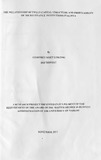| dc.description.abstract | Over the last 20 years, microfinance institutions in Kenya have largely developed through concerted grant funding. This situation prevailed up to the late 1990s when key donors started pushing MFIs to start moving towards sustainability in their operations. Most MFIs in Kenya had started off as NGOs and had built significant supply side competencies. The push towards sustainability was therefore not going to be easy for institutions previously focused on free spending outreach drives, rather than sustainable operations.
This study used descriptive statistics. Descriptive statistics are used to describe the main features of a collection of data in quantitative terms. One important use of descriptive statistics is to summarize a collection of data in a clear and understandable way. This study used data for registered selected MFIs in Kenya for the period during 2006-2009. Profitability of MFIs were measured using return on assets since MFIs do not have shareholders equity, capital structure of MFIs was measured using short term debts divided by total (SDA) assets, long term debts divided by total assets (LDA) and total debts divided by total assets (DA), size of the MFIs was used as control variables and was measured using logarithms of total assets In determining the relation between profitability and capital structure of MFIs, the researcher used multiple regression Analysis method. With multiple regression analysis method it is possible to express the model that will be used in studying the relation between capital structure and profitability and variables we want to examine (SDA, LDA, DA , SIZE and ROA).
The capital structure decision is crucial for any business organization. The decision is important because of the need to maximize returns to various organizational constituencies, and also because of the impact such a decision has on an organization’s ability to deal with its competitive environment. From the findings the study found that that most of MFIs in Kenya were using equity and or donations as their main source finances in Kenya which accounted for by 72.42% and 27.58% in form of debt. The study further found that there exist a positive relationship between capital structure and profitability of MFIs in Kenya | en_US |



